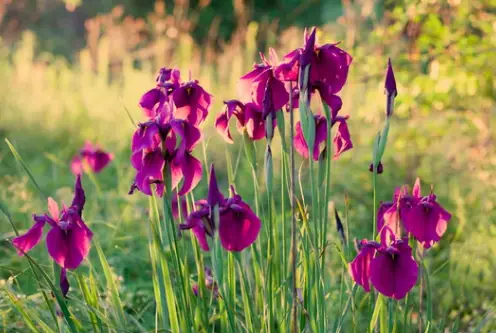Irises are enchanting flowers that captivate with their stunning blooms and vibrant colors.
Whether you’re an avid gardener or a flower enthusiast, knowing where irises grow best is crucial to ensure their optimal growth and showcase their true beauty.
In this blog post, we will explore the ideal growing conditions for irises, including sunlight, soil requirements, watering needs, and other essential factors that contribute to their successful cultivation.
Where Do Irises Grow Best?

Where Do Irises Grow Best
It’s important to note that while irises can adapt to different climates and growing conditions, specific varieties may have different preferences. Before growing irises in a particular region, it’s recommended to consult local gardening resources, nurseries, or experienced gardeners to determine which iris varieties are best suited for that specific climate and location.
Overall, irises are versatile plants that can be successfully grown in various regions, and with the right care and attention, they can bring beauty and color to gardens around the world.
Here are 7 Requriements For Grwoing Irises Below:

1. Sunlight Requirements
One of the key factors that influence the growth and blooming of irises is sunlight.
Irises generally thrive in locations that receive ample sunlight. Ideally, they require a minimum of six hours of direct sunlight per day to produce abundant and healthy blooms.
Therefore, it is recommended to plant irises in areas with full sun exposure, such as open garden beds or sunny borders.
2. Soil Conditions

Irises are versatile plants when it comes to soil conditions, but they do have specific preferences.
Well-drained soil is essential for their growth and prevents root rot. Sandy loam or loamy soil is generally ideal for irises, allowing proper drainage while retaining sufficient moisture.
Before planting, it’s advisable to amend heavy clay or sandy soils with organic matter, such as compost or well-rotted manure, to improve the soil structure and enhance its water-holding capacity.
3. Watering Needs
Proper watering is crucial for irises to thrive. While they require consistent moisture, they don’t tolerate excessive wetness.
It’s important to strike a balance between providing enough water and avoiding waterlogged conditions. Irises should be watered deeply once or twice a week, depending on the weather conditions.
This allows the water to penetrate the root zone, promoting healthy growth.
However, it is crucial to ensure that the soil has dried out slightly before the next watering session to prevent the risk of rotting or fungal diseases.
4. Climate Considerations
Irises are known for their adaptability to various climates. However, specific iris varieties thrive better in certain climatic conditions.
Bearded irises, one of the most common types, prefer temperate climates with distinct seasons. They require a period of winter dormancy to produce abundant blooms in spring.
On the other hand, Siberian irises, as the name suggests, are well-suited for cooler regions and can tolerate colder winters.
Understanding the climate and choosing iris varieties that are best suited for your specific region will greatly contribute to their successful growth.
It’s advisable to consult local gardening resources or nurseries to determine which iris varieties are most suitable for your climate.
5. pH Level and Fertilization

Maintaining the right pH level in the soil is crucial for the optimal growth of irises.
A pH range of 6.0 to 7.5 is generally ideal for irises.
Conducting a soil test will help determine the soil’s pH level and identify any necessary amendments.
If the soil is too acidic, adding lime will help raise the pH, while sulfur can be used to lower it if it’s too alkaline.
In terms of fertilization, irises are not heavy feeders but benefit from a balanced application of fertilizer.
Before planting, incorporating a slow-release granular fertilizer or well-balanced organic fertilizer into the soil will provide the necessary nutrients for healthy growth.
Also, a light application of balanced fertilizer in early spring, just as the new growth emerges, can promote robust blooming.
6. Proper Spacing
When planting irises, proper spacing is essential to prevent overcrowding, promote good airflow, and reduce the risk of diseases.
Space rhizomatous irises, such as bearded irises, around 12 to 24 inches apart, allowing sufficient room for their growth and the development of multiple rhizomes.
For clump-forming irises, like Siberian irises, a spacing of 12 to 18 inches is generally recommended.
7. Pest and Disease Management
While irises are generally hardy plants, they can be susceptible to certain pests and diseases.
Common pests that may affect irises include iris borers, thrips, and aphids.
Regular inspection of the plants and taking necessary preventive measures, such as applying organic insecticides or removing affected foliage, can help control pest populations.
Fungal diseases like leaf spot and root rot can also pose a risk to irises.
To prevent these diseases, ensure proper soil drainage, avoid overhead watering, and maintain good air circulation around the plants.
Promptly removing any infected foliage and applying appropriate fungicides when necessary can also help manage these issues effectively.
Conclusion
Growing irises successfully requires understanding their specific needs and providing them with the ideal growing conditions.
With factors such as sunlight, soil conditions, watering, climate, pH level, spacing, and pest and disease management, you can ensure that your irises thrive and reward you with their magnificent blooms.
Remember, irises are resilient plants that can adapt to various conditions, so don’t be discouraged if your garden doesn’t meet all the requirements perfectly.
With a little care, attention, and the right knowledge, you can create a beautiful iris garden that brings joy and color to your outdoor space. Happy gardening!
Refernce:
- American Iris Society. (n.d.). Iris Culture: Growing Iris. Retrieved from https://www.irises.org/growing-irises
- Colorado State University Extension. (2019). Growing Bearded Iris. Retrieved from https://extension.colostate.edu/topic-areas/yard-garden/growing-bearded-iris-7-400/




